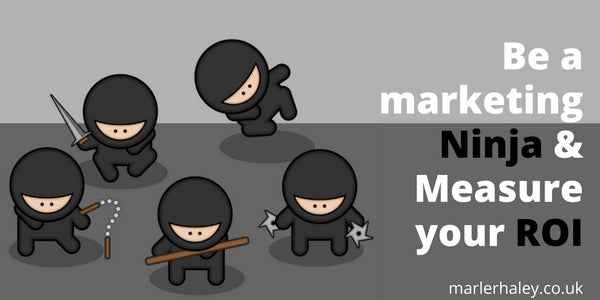0800 072 7742
0800 072 7742


But, if you follow these top tips, you’ll be able to measure ALL of your campaigns both online and offline and become a marketing ninja.
Use website tracking software such as Google Analytics and set up ‘goals’ to monitor the number of people who submit enquiries or who order online.
Make sure you define what you see as a commercial goal as this will vary for each business.
Compare how much you invested in online marketing channels such as SEO, PPC and email at least on a monthly basis against how many leads and sales you gained via these channels.

So for example, if I gained £110 sales and I spent £100 during this time on these channels, my %ROI would be a 10% – meaning that I’ve gained 10% more sales than I spent.
Measuring the success of a print campaign can undeniably be a headache for marketers. But it is possible.
For example, if your print campaign is based upon a certain action – such as visiting a webpage or a special offer, make sure that it can be directly attributed back to that print campaign.
Use tracking on special URLs such as websiteaddress.com/offer so you know that anybody landing on that page has come via your print campaign.
Or if you use a special voucher code, then monitoring its use will tell you your ROI.
You could even add specific telephone numbers that are related to the print campaign so that if that number calls into your business, you know that it can be attributed to that campaign.
This one seems to be tricky for most marketers, probably because the event takes so much pre-planning, during-planning and follow up that tracking ROI often feels like the least of their worries!
Pretty much everything can be measured at your event – from how much your exhibition stands cost to the number of people you talk to, to the more hard cash number of people who converted into a lead or sale.
If you’ve got the easy to monitor option of ‘sales’, then simply use the ROI calculator to work out your % ROI after the event. Monitor both directly after the event and about 3-6 months down the line as you may have future sales too that can still be attributed to the show.
If you’ve got a harder aim such as ‘brand awareness’, then monitor the number of people who add their name to email lists or who interact with you on social media. Make sure you give them a reason to interact with you – such as the chance to win a competition etc.
Before we yell ‘action’, let’s decide on a goal. What do we want to achieve through your advert? Usually, increased sales are the main goal, but sometimes you’ll want to improve your reputation or launch a new product or service.

If sales is the name of the game, you’ll need to have an accurate record of your sales history – else you’ll have nothing to compare it to!
Compare your increase in sales on an ongoing basis after launch. Compare your expected growth by comparing month on month growth against your year on year figures and anything above it could be attributed to your broadcast.
Here’s an example. If my year on year growth figures for revenue are on average 10% and the month your advert went live escalated to 12% growth year on year, then you can claim that your broadcast caused a 20% increase in growth.
| Year on Year growth | Growth formula | % growth in growth | |
| Jan-March average | 10% | ||
| April (ADVERT) | 12% | ((10-12)/10)*100 | 20% |
If you’re advertising a specific product – expect those search terms to increase due to the ‘halo’ effect of people searching more for items relating to your advert – whether that’s your brand name or the name of product.
All of these mediums have traditionally been thought of as completely different. They take different skills to be successful but they all have the same thing in common.
Working out their ROI can be difficult but it’s made a lot easier if you pre-define your goals. So no matter what channel you’re working on, decide on what actions you’d deem to be successful from the campaign and make sure you can measure it.